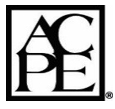Pharmacy-Based Point-of-Care Test and Treat National Certificate Program
Upcoming Dates
Nov. 20
12:30-4:30 p.m. ET
Virtual
NOTE: The NASPA Pharmacy-Based Point-of-Care Test and Treat National Certificate Program does not meet the requirements of the Florida Board of Pharmacy’s rules for Test and Treat certification or continuing education programs for Florida pharmacists and pharmacy technicians. Florida pharmacy teams, please click here for more information on the FL training.
Program Information
The NASPA Pharmacy-Based Point-of-Care Test and Treat National Certificate Program provides an opportunity to gain the skills and information necessary to develop a testing program such as influenza, Group A Streptococcus, HIV, Hepatitis C, coronaviruses, and chronic diseases. The target audience for the certificate program is pharmacists, pharmacy technicians, student pharmacists, academia, and pharmacy association staff. While the program is primarily designed for pharmacists, non-pharmacists interested in point-of-care test and treat are also welcome to complete the program.
The 20-hour ACPE-accredited certificate program includes comprehensive material regarding key disease states, physical assessment, point-of-care tests, collaborative practice models, and business models through:
- 16 hours of home study
- 4 hours of live training
- Skills Assessment
Participants take an online assessment after each of the 12 home study modules and a cumulative assessment (must pass 70% within three attempts). Then, proficiency to conduct physical assessments and offer point-of-care testing services is assessed after the live/virtual training.
Upon successful completion of all three portions of the program and all program evaluations, participants are awarded a certificate of completion. Pharmacists can receive 20 hours of Continuing Pharmacy Education (CPE) credit.
Learning Objectives
At the completion of this activity, the pharmacist will be able to:
- Identify opportunities for expanding patient-centered services in pharmacy settings using point-of-care testing and treatment.
- Discuss the value and limitations of patient-reported symptoms, medical history, and drug allergies.
- Describe and perform the following physical assessments, when appropriate to patient care: blood pressure, pulse, respiratory rate, oxygenation, and cervical lymph node inspection.
- Describe and perform the following specimen collections used in point-of-care testing: Throat swab and nasal swab
- Identify characteristics of exemplar infectious diseases (influenza, group A streptococcus, human immunodeficiency virus, hepatitis C, coronaviruses) regarding causative agents, transmission, immunizations, symptoms and presentation, appropriate therapy, point-of-care testing.
- Define and contrast the following terms as they relate to point-of-care testing in community pharmacies: CLIA, CLIA-waived, collaborative agreement, protocol, prescribe and diagnose.
- Explain the value and limitations of point-of-care tests, including rapid diagnostic tests, and list the steps a pharmacist can take to improve test performance.
- Apply all information to patient-specific cases based on common community pharmacy-based patient interaction.
At the completion of this activity, the pharmacy technician will be able to:
- Identify opportunities for expanding patient-centered services in pharmacy settings using point-of-care testing and treatment.
- Discuss the value and limitations of patient reported symptoms, medical history, and drug allergies
- Describe and perform the following physical assessments, when appropriate for patient care: blood pressure, pulse, respiratory rate, oxygenation, and cervical lymph node inspection.
- Describe and perform the following specimen collections used in point-of-care testing: throat and nasal swabs.
- Identify characteristics of exemplar infectious diseases (influenza, Group A Streptococcus, Human Immunodeficiency Virus, Hepatitis C, Coronaviruses) regarding causative agents, transmission, immunizations, symptoms and presentation, and point-of-care testing.
- Define and contrast the following terms as they relate to point-of-care testing in community pharmacies: CLIA, CLIA-waived, collaborative agreement, protocol, prescribe, and diagnose.
- Explain the value and limitations of point-of-care tests, including rapid diagnostic tests.
Registration Costs
NCPA Member $295
NCPA Nonmember $495
Cancellation is subject to a $125 Cancellation Fee
If you are unable to attend the live training after registering for the program, you will be subject to a $125 Cancellation Fee
On-Demand Learning Hours
Exploring the Point-of-Care Testing Cash Payment Model (Beyond COVID-19)
What’s the difference between your POCT cash price and a copay for a similar test from urgent care? Probably not much. People will pay a premium for convenience, and your pharmacy provides tremendous bang for your buck without waiting for third-party reimbursement. Join us as we sit down with pharmacy owner Denise Conway to discuss her pharmacy’s cash pay model for POCT and get ideas to grow your program and revenue.
NOTE: The NASPA Pharmacy-based Point-of-Care Test and Treat National Certificate Program does not meet the requirements of the Florida Board of Pharmacy’s rules for Test and Treat certification or continuing education programs for Florida pharmacists and pharmacy technicians.
 Michigan Pharmacists Association is accredited by the Accreditation Council for Pharmacy Education (ACPE) as a provider of continuing pharmacy education.
Michigan Pharmacists Association is accredited by the Accreditation Council for Pharmacy Education (ACPE) as a provider of continuing pharmacy education.
Credit is only awarded for completion of the entire 20 contact hour program. Credit must be claimed within 30 days of completing the program.
Questions? Email Kathy Doucette at [email protected]
ACPE Universal Activity #0112-0000-24-200-B04-P/T
Activity Type: Practice-based
Target Audience: Pharmacists and pharmacy technicians in all practice settings
Release Date: December 1, 2024
Expiration Date: December 1, 2027
Contact Hours: 20.0
A Guide to Point-of-care testing
Point-of-care testing (POCT) provides an excellent opportunity for community pharmacy teams to enhance patient care and expand revenue-generating services while improving health at the patient and population levels.
